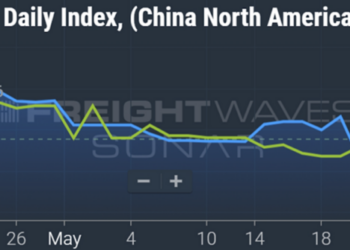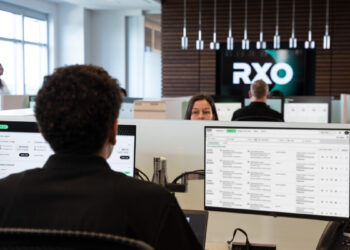Should hydrogen ever become the long-distance trucking fuel of the future, its abilities are increasingly likely to be proved out first in applications other than an 18-wheeler.
One test of hydrogen’s reliability as a fuel is ongoing along the San Francisco waterfront, where a company called Switch is already operating a hydrogen-powered ferry, the Sea Change. The catamaran ferry launched in August.
The ability to move from one hydrogen-powered vessel to a bigger fleet got a boost last month with a $10 million investment in Switch by Nexus Development Capital. Nexus’ CEO, Josh Kaufman, described it in an interview with FreightWaves as a fund that backs teams developing low-carbon infrastructure. He said Nexus considers itself more as “early-stage infrastructure” capital rather than traditional venture capital.
Kaufman described the work that Switch had done with the Sea Change to be “really the most advanced decarbonized asset in the country.” Discussions between Switch and Nexus went on for 18 months before the commitment was made.
And while there are plenty of funds out there that are investing in more traditional renewable energy sources like wind and solar, those funds are “just not quite comfortable with a lot of other sectors,” Kaufman said. Hydrogen would be one of them and “that can be because the business model is not proven yet or there are still development risks.”
Pace Ralli, CEO and founder of Switch, said his background was in “the utility world” but that he had been looking at the decarbonization of shipping since 2012. It was about that time that the International Maritime Organization was beginning to look at reducing the carbon footprint of shipping, an effort that led to a historic deal earlier this year.
Ralli told FreightWaves that “even though we’re at an early stage, what the investment allows us to do is really just sort of switch our focus to expanding the fleet.”
He added that Switch has “new commercial opportunities that we’re advancing with this capital and start building new vessels.”
The Sea Change is not a retrofit; it was built from the ground up at a shipyard in Bellingham, Washington. Its operation was approved by the U.S. Coast Guard.
In the announcement of the Nexus investment in Switch, the companies said that Coast Guard approval was not only necessary but provides a further pathway to growth. “Establishing a regulatory framework for this technology unlocks the possibility of progressing to larger ferry designs capable of operating at higher speeds on longer routes,” the prepared statement said.
By not being a retrofit, and by delivering a finished hydrogen-powered ferry, Switch is able to push one of its value propositions: It’s a turnkey solution.
As the company said in its announcement of the Nexus investment, Switch takes care of the vessel design and construction, leasing options and “pre-packaged carbon neutral fueling.”
Ralli said he can see the maritime industry being large enough to serve as a base for greater penetration of hydrogen into other areas. It can help provide supply “and that’s going to be a benefit to trucking.”
For now, Ralli said, there are adequate supplies of hydrogen in the San Francisco Bay Area to ensure that the Sea Change will not have any difficulty finding fuel.
In the push by the renewable industry to move into transportation markets, total cost of ownership is touted for the next generation of fuels. That effort tries to get past the upfront costs of renewable cars or trucks, which are often significantly higher than conventional transportation modes, and instead focus on the long-term financial benefits from electric engines and the alternative fuel that powers them.
Also at play might be tax credits, which is the case with hydrogen as green hydrogen, produced from renewables, earns a tax credit that is roughly equivalent to about $3 per gallon in a comparison with diesel. This is particularly true in California, where transportation using low-carbon fuels can earn Low Carbon Fuel Standard credits. The prices have fallen considerably from the high-water mark earlier this year but would still be a factor in the total cost of ownership.
Hydrogen as a transportation fuel primarily takes three forms. One is what is happening on the Sea Change: Hydrogen is injected into an onboard fuel cell, a chemical reaction converts it to electricity and an electric motor is powered by that.
Another is to introduce the hydrogen into an engine via ammonia, which is a combination of hydrogen and nitrogen but has the advantage of being plentiful given its role as a fertilizer. The ammonia can be combusted but that creates significant emissions of nitrous oxide (Nox).
Getting hydrogen from ammonia without the Nox emissions is the core of the approach being spearheaded by several companies, including Amogy. That New York-based startup is also looking to ships as its basis, constructing a prototype system that will take in ammonia, crack it into hydrogen and nitrogen and vent the latter into the atmosphere, where it already is the primary element in the air that people breathe. The hydrogen then is fed into a fuel cell, like with the Sea Change, and the resulting electricity powers the boat.
More articles by John Kingston
Fuel cell maker CEO boosts use of hydrogen on the rails
Amazon-funded startup tackles storage issue as key in hydrogen trucking
Environmental group raises caution flag on hydrogen’s impact as fuel
The post Hydrogen’s slow march as fuel gets boost on San Francisco waterfront appeared first on FreightWaves.













